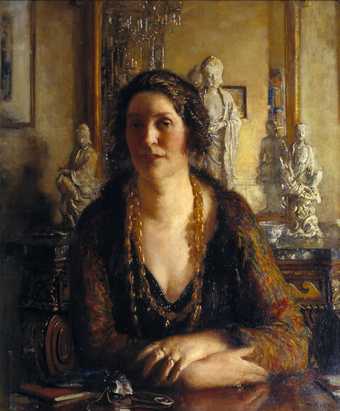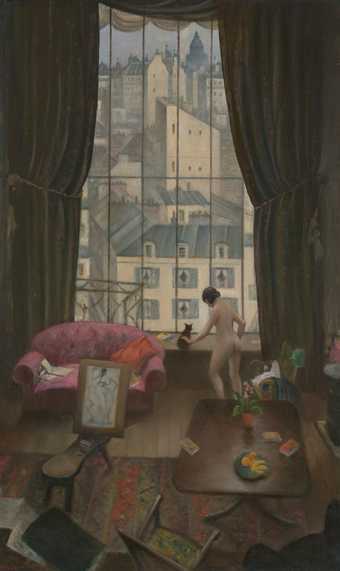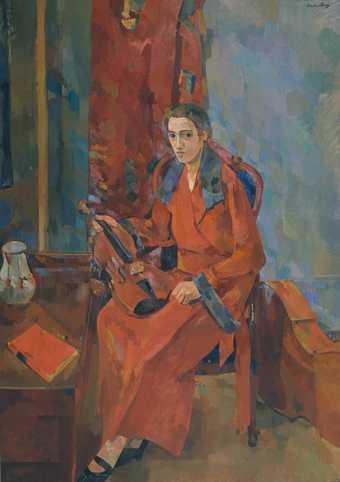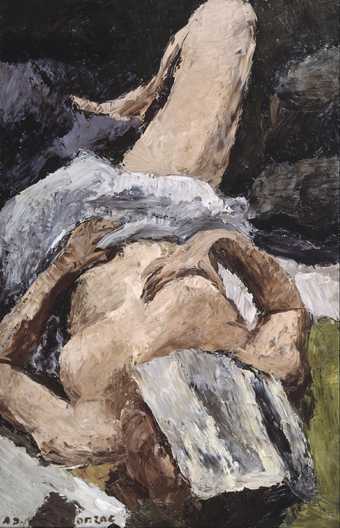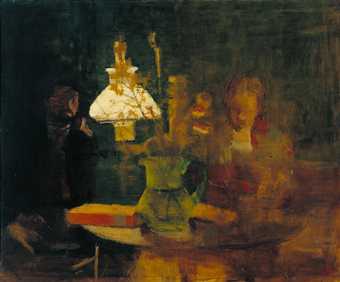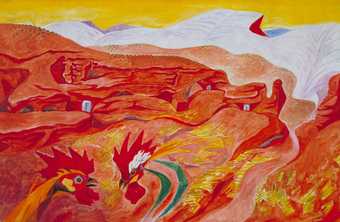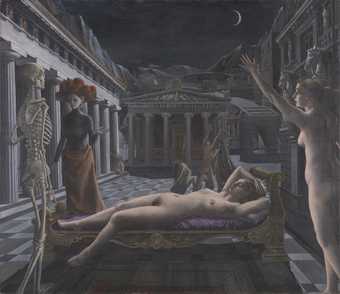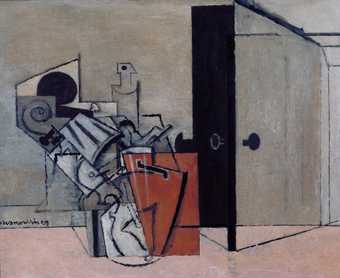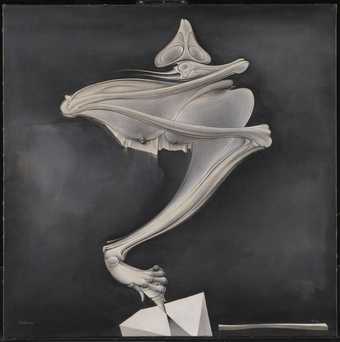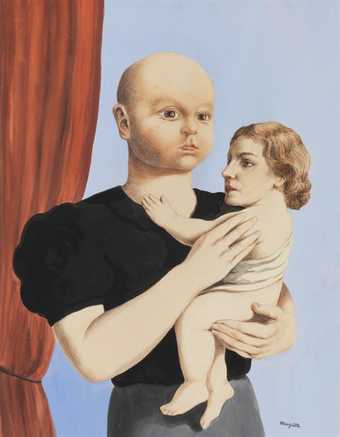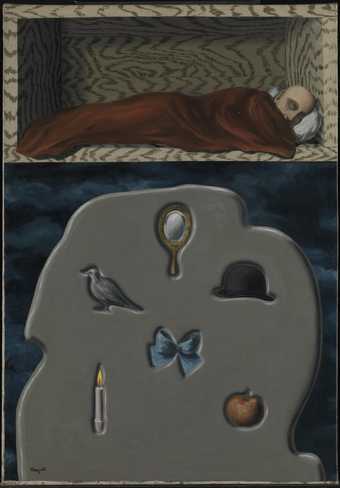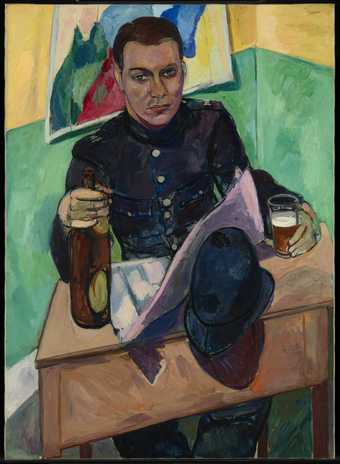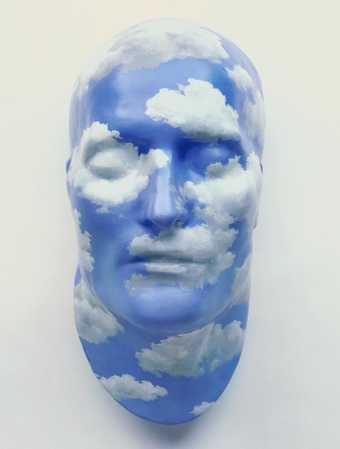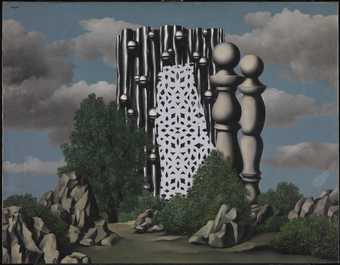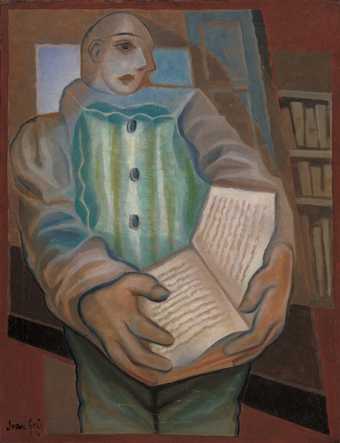
In Tate Modern
- Artist
- René Magritte 1898–1967
- Original title
- L'Homme au journal
- Medium
- Oil paint on canvas
- Dimensions
- Support: 1156 × 813 mm
frame: 1279 × 940 × 75 mm - Collection
- Tate
- Acquisition
- Presented by the Friends of the Tate Gallery 1964
- Reference
- T00680
Display caption
Magritte’s deadpan style is seen clearly in these four simply painted scenes. Each section seems to be exactly the same, apart from the disappearance of the man reading the newspaper. There are slight changes of perspective between the four panels. This can be seen by focusing on the view out of the windows. This shift adds to the slightly unsettling effect in the painting. It may relate to the displacement of images in early 3D viewing devices. This subtle undermining of the everyday was typical of Magritte and his Belgian surrealist colleagues. They preferred quiet subversion to obvious public action.
Gallery label, August 2020
Does this text contain inaccurate information or language that you feel we should improve or change? We would like to hear from you.
Catalogue entry
René Magritte 1898-1967
T00680 L'Homme au Journal
(Man with a Newspaper) 1928
Inscribed 'Magritte' b.r.
Oil on canvas, 45 1/2 x 32 (115.5 x 81)
Presented by the Friends of the Tate Gallery 1964
Prov:
P.G. Van Hecke, Brussels; with Galerie l'Epoque, Brussels; with Galerie Schwarzenberg, Brussels; E.L.T. Mesens, Brussels; Marcel Mabille, Brussels; with René Withofs, Brussels; with Hanover Gallery, London; Friends of the Tate Gallery
Exh:
Guiette, Magritte, Picard, Palais des Beaux-Arts, Brussels, December 1931-January 1932 (37) dated 1930; René Magritte, Julien Levy Gallery, New York, January 1936 (not listed, repr.); René Magritte, Palais des Beaux-Arts, Brussels, May-June 1954 (24); René Magritte, Musée des Beaux-Arts, Ixelles, April-May 1959 (14); René Magritte, Musée des Beaux-Arts, Liège, October-November 1960 (7); L'Oeuvre de René Magritte, Casino, Knokke-Le Zoute, July-August 1962 (11, repr.); René Magritte, Hanover Gallery, London, May-July 1964 (13, repr.); René Magritte, Museum of Modern Art, New York, December 1965-February 1966 (6, repr.) dated 1927-8; Rose Art Museum, Waltham, Mass., April-May 1966 (6, repr.); Art Institute of Chicago, May-July 1966 (6, repr.); Pasadena Art Museum, August-September 1966 (6, repr.); University Art Museum, University of California Museum, Berkeley, October-November 1966 (6, repr.); René Magritte, Museum Boymans-van Beuningen, Rotterdam, August-September 1967 (12, repr.), dated 1927; Moderna Museet, Stockholm, September-November 1967 (8, repr.); Surrealism, National Museum of Modern Art, Tokyo, September-November 1975 (31, repr.); National Museum of Modern Art, Kyoto, November 1975-January 1976 (31, repr.)
Lit:
Louis Scutenaire, René Magritte
(Brussels 1947), p.92, dated 1930; A.M. Hammacher, René Magritte
(London 1974), p.82, repr. p.83 in colour; A.N. Girling, '"Man with a Newspaper" (R. Magritte, 1898-1967)' in The Stereoscopic Society Bulletin, No.54, June 1975, pp.5416-18; Harry Torczyner, Magritte: ideas and images
(New York 1977), p.53, repr. p.52 (the Bilz engraving repr. p.53)
Repr:
Variétés, 1, No.9, 15 January 1929, between pp.512-13 as 'L'Homme au Journal'; Julien Levy, Surrealism
(New York 1936), p.144 as 'Now you don't' 1928
Magritte told André Bosmans in a letter of 6 December 1960 that the image of a man seated in a room was based on an illustration [reproduced p.462: not reproduced here] in The Natural Method of Healing
by F.E. Bilz, an enormously popular 'new and complete guide to health' first published in 1898 in German and translated shortly afterwards into various other European languages. (The English language edition of 1901, in which it appears in volume 2, p.1355, records on the title page that upwards of 850,000 copies had been sold). The book is illustrated with a large number of quaint steel engravings. This particular one was done to illustrate an '"Ideal" Incandescent fuel stove with flue' recommended by Professor Bilz 'for any place where there is no chimney, and where much warmth is required'. Magritte followed the main lines of the composition, but eliminated a number of details and simplified the forms throughout. The most conspicuous changes are that the pipe runs vertically upwards instead of bending almost at right angles; the shelf and the vase with peacock feathers have been eliminated; the curtains are different and the view through the window is of landscape instead of buildings; there are more flowers on the window ledge; the object in the foreground is a stool instead of a chair; and the man is not smoking. Mme Magritte confirms that there is a copy of the French language edition of this book in her husband's library and that this particular page is missing, having probably been extracted to work from.
The repetition of the same image in four compartments (almost identical except for the presence of the seated man in the upper left section only) is itself highly unusual in Magritte's work. A.N. Girling, in an article in The Stereoscopic Society Bulletin, has pointed out that 'cross-eyed' viewing of the two pairs of images, and especially the lower pair, produces a strongly three-dimensional stereoscopic effect, which because of a slight sideways displacement of the images he believes must have been deliberate. However, Mme Magritte writes (letter of 20 January 1977) that she never heard her husband speak of stereoscopes, that he took no interest in the bizarre pairs of photographs of a stereoscopic kind and that the family never possessed a stereoscope. It may be added that the table and stools have also been shifted downwards in the lower pair of images, and one looks more down onto them.
Though the painting was reproduced by Julien Levy in 1936 as 'Now you don't', Magritte confirmed that the original title was 'Man with a Newspaper'. When asked whether it could have any connection with Bergson's theories of time on account of its repetition of an image and the fact that a man is present in one compartment but is absent from the other three, he replied (31 July 1965): "'Man with a Newspaper" ... like my other paintings, is concerned with the description of a thought combining forms (visual) drawn from the tangible world - but in such a way that mystery is evoked.
'This thought is inspired in the sense that it both resembles forms of the visual world AND
that it evokes the mystery without which no world and no thought would be possible.
'I regard the description of inspired thought as poetry.
'Inspired thought (as I understand it) arises spontaneously: one may search for it but it comes independently of the "will".
"'Man with a Newspaper" is the image of a thought and the latter does not correspond to a philosophical doctrine.
'Bergson's theories describe ideas; what I paint contains no idea. I paint something to be seen: "an image in itself' which is the image of a thought "in itself". This thought (like all mystery) defies interpretation.
'However, it is possible to speak of this thought, to comment on the image which describes it. To do this well requires inspiration.'
Though this picture was exhibited at the Palais des Beaux-Arts in Brussels in 1931-2 with the date 1930, it was first reproduced in the issue of Variétés
dated 15 January 1929. Magritte himself, in the letter quoted above, confirmed that it was painted in 1928. David Sylvester, who dates it late 1928, says that X-ray photographs of the rather larger picture 'The Annunciation' 1930 (114.5 x 146.5cm, formerly coll. E.L.T. Mesens) show the presence of a different composition underneath, including what appears to be the same figure of a seated man reading a newspaper.
Published in:
Ronald Alley, Catalogue of the Tate Gallery's Collection of Modern Art other than Works by British Artists, Tate Gallery and Sotheby Parke-Bernet, London 1981, pp.461-4, reproduced pp.461 and 462
Explore
- architecture(30,960)
- formal qualities(12,454)
-
- repetition(391)
- domestic(1,795)
- recreational activities(2,836)
-
- reading(400)
- fine arts and music(3,982)
-
- picture(248)
- stove(25)
You might like
-
Sir Walter Russell The Amber Beads
exhibited 1926 -
Christopher Richard Wynne Nevinson A Studio in Montparnasse
exhibited 1926 -
Simon Levy The Musician
1925 -
André Dunoyer de Segonzac Nude with a Newspaper
1921 -
Victor Pasmore Lamplight
1941 -
André Masson Ibdes in Aragon
1935 -
Paul Delvaux Sleeping Venus
1944 -
Louis Marcoussis Interior with a Double Bass
1929 -
Hans Bellmer Peg-Top
c.1937–52 -
René Magritte The Spirit of Geometry
1937 -
René Magritte The Reckless Sleeper
1928 -
Edward Wolfe P.C. 77
c.1927 -
René Magritte The Future of Statues
1937 -
René Magritte The Annunciation
1930 -
Juan Gris Pierrot with Book
1924

